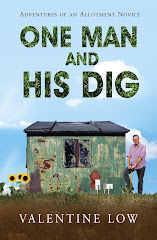 After 11 years, seven months, two weeks and two days of marriage (not that I'm counting) I am pleased to be able to say that my wife and I don't generally have too many disagreements. We like the same movies, the same food, the same music (some of the time) and, best of all, we both love doing the allotment. The only regret is that we are not often able to go there at the same time.
After 11 years, seven months, two weeks and two days of marriage (not that I'm counting) I am pleased to be able to say that my wife and I don't generally have too many disagreements. We like the same movies, the same food, the same music (some of the time) and, best of all, we both love doing the allotment. The only regret is that we are not often able to go there at the same time.Occasionally, however, we have slightly differing ideas about what to grow on our plot, and over the years I have learned a lot about the delicate art of compromise. I have, for instance, generously permitted the cultivation of beetroot, a vegetable which in my opinion is fit only to be fed to farm animals (and then only if they have been very naughty).
The other area where I have had to give in is on the subject of coloured vegetables. I am something of a traditionalist, believing that vegetables should be the colour they were when I was a lad: carrots should be orange, cabbages should be green, tomatoes should be red. My wife, however, thinks that there is no point in growing your own unless you include some interesting varieties. And that means growing a few fancy coloured ones, like purple Brussels sprouts and Red Russian kale.
For the past few years we have grown yellow courgettes alongside the traditional green ones. I have to admit they are pretty good, too. But the variety we grew last year, Soleil, turned out all wrong - a rather bilious shade of yellow with green streaks. They looked seasick. I don't know what went wrong, but I thought we had better try another one this year.
The question is, which? We once grew Taxi, which did pretty well our first year, but it is not widely available these days. Anyway, I am not sure I approve of growing a vegetable named after a New York cab on a London allotment. Some people rate Gold Rush highly, while others swear by Orelia. Then there's Parador, and Jemmer, not to mention One Ball, which are yellow and round. It is all very difficult. Perhaps I can interest my wife in the Italian variety Lungo Bianco, which is white, or Nero di Milano, which is black, or at least the sort of very dark green that passes for black. Then there is always Rugosa Friulana, a warty thing described by Seeds of Italy as "very ugly" - they're not joking - but also extremely flavoursome. Still, I've got about three months to go before I have to sow my courgettes: I expect I will have made up my mind by then.



